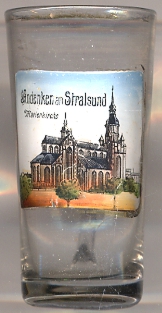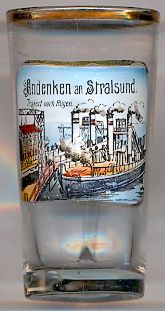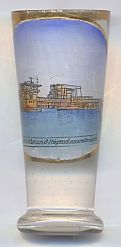

|
| DEUTSCHLAND | GERMANY |
| Bundesland: Mecklenburg-Vorpommern | Mecklenburg-West Pomerania |
| Landkreis: Vorpommern-Rügen |
Stralsund is situated at the southern coast of the Strelasund, a sound of the Baltic Sea separating the island of Rügen from the mainland. A bridge (the Rügendamm) and several ferry services connect Stralsund with the ports of Rügen As of 2005 the city had a population of about 58,700
Lübeck, which burnt Stralsund down in 1249. Afterwards the town was rebuilt with a massive city wall having 11 town gates and 30 watchtowers. In 1293 Stralsund became a member of the Hanseatic League. 300 ships flying the flag of Stralsund cruised the Baltic Sea in the 14th century. In the 17th century Stralsund became a theatre in the Thirty Years' War. General Albrecht von Wallenstein besieged the city in 1628 until Swedish troops came to Stralsund's aid and forced the general to retreat. After the war the Peace of Westphalia (1648) handed Western Pomerania, Swedish Pomerania and the city of Stralsund to Sweden. In the Great Northern War in 1715 King Charles XII of Sweden led the defence of Stralsund for a year against the united European armies. Stralsund remained under Swedish control until 1815, when the Congress of Vienna handed it over to Prussia. In 2002, the historic town centres of the cities of Stralsund and Wismar were listed as a World Cultural Heritage by UNESCO (see also list of other UNESCO heritage sites). After the re-unification of Germany in 1990, the prefix 'Hansestadt' was again added to the city's name.
 The
The  Marienkirche (St. Mary's Church) [left] was built some time before 1298
an is an example of the brick Gothic style prevalent in northern Germany. Between 1625 and 1647, it was the tallest building in the world at 151 metres tall.
The bell tower collapsed in 1382, and was rebuilt by 1478. In 1495, the steeple tower blew down during a severe storm, and was then rebuilt taller.
This was subsequently struck by lightning in 1647, and burned down, and was rebuilt as a baroque dome, which, completed in 1708, can be seen today.
The tower is currently 104 metres tall.
Marienkirche (St. Mary's Church) [left] was built some time before 1298
an is an example of the brick Gothic style prevalent in northern Germany. Between 1625 and 1647, it was the tallest building in the world at 151 metres tall.
The bell tower collapsed in 1382, and was rebuilt by 1478. In 1495, the steeple tower blew down during a severe storm, and was then rebuilt taller.
This was subsequently struck by lightning in 1647, and burned down, and was rebuilt as a baroque dome, which, completed in 1708, can be seen today.
The tower is currently 104 metres tall.
[http://en.wikipedia.org/wiki/St._Mary's_church,_Stralsund]
 Glass no. 2361 [near left] shows the
Glass no. 2361 [near left] shows the  traject to Rügen, a ferry system for rail coaches.
In 1878 Stralsund had been connected to the railroad from Berlin.
The owners of the passenger ferries had filed a lawsuit against the traject because they feared a danger for their businesses. They
received a compensation of 80,000 gold marks; with the money they purchased a paddlesteamer which remained in use until 1949.
The railway traject from Stralsund to Rügen was opened in 1883. Originally, it had been planned for about 30,000 to 40,000
passengers per year, and two ships, the "Prinz Heinrich" and the "Rügen" were put into service.
The ships were built as icebreakers to be used also in winter. Already in the first season, the traject transported some 90,000
passengers, so that already in 1889 a third ship, the "Stralsund", was put into service.
After 1897, when the railway lines on Rügen were upgraded, two new trajects, the "Sassnitz" and the "Putbus",
which each could carry 3 railway coaches, were added to the flotilla. Both in Stralsund and in Altefähr on Rügen two ships could be
handled at the same time. Per day, two pairs of express trains ran between Berlin and Sassnitz.
However, moving the trains on and off the ships was time-consuming. And although an additional traject from Sassnitz to
Trelleborg in Denmark revived the business, it soon became obvious that a bridge between the mainland and the island of Rügen
would be desirable. An initial project for bridge between Dänholm and Rügen was not carried out because World War I had
broken out. Although in 1920 a further ship, the "Altefähr", was added, the ships did not have enough capacity to carry
one train as a whole; each train had to be separated into two parts and was carried by two ships. In addition, the railway ferries
between Warnemünde (today part of Rostock) and Gedser (Denmark), opened in 1904, and another one from
Gdingen (now Gdynia, Poland) to Aarhus proved to be
a severe competition. In 1929, some 185,000 passengers had to be carried to and from Rügen, necessitating up to 90 crossings
per day. The preparations for the new project of a bridge acorss the Strelasund, the Rügendamm, finally began in 1930.
traject to Rügen, a ferry system for rail coaches.
In 1878 Stralsund had been connected to the railroad from Berlin.
The owners of the passenger ferries had filed a lawsuit against the traject because they feared a danger for their businesses. They
received a compensation of 80,000 gold marks; with the money they purchased a paddlesteamer which remained in use until 1949.
The railway traject from Stralsund to Rügen was opened in 1883. Originally, it had been planned for about 30,000 to 40,000
passengers per year, and two ships, the "Prinz Heinrich" and the "Rügen" were put into service.
The ships were built as icebreakers to be used also in winter. Already in the first season, the traject transported some 90,000
passengers, so that already in 1889 a third ship, the "Stralsund", was put into service.
After 1897, when the railway lines on Rügen were upgraded, two new trajects, the "Sassnitz" and the "Putbus",
which each could carry 3 railway coaches, were added to the flotilla. Both in Stralsund and in Altefähr on Rügen two ships could be
handled at the same time. Per day, two pairs of express trains ran between Berlin and Sassnitz.
However, moving the trains on and off the ships was time-consuming. And although an additional traject from Sassnitz to
Trelleborg in Denmark revived the business, it soon became obvious that a bridge between the mainland and the island of Rügen
would be desirable. An initial project for bridge between Dänholm and Rügen was not carried out because World War I had
broken out. Although in 1920 a further ship, the "Altefähr", was added, the ships did not have enough capacity to carry
one train as a whole; each train had to be separated into two parts and was carried by two ships. In addition, the railway ferries
between Warnemünde (today part of Rostock) and Gedser (Denmark), opened in 1904, and another one from
Gdingen (now Gdynia, Poland) to Aarhus proved to be
a severe competition. In 1929, some 185,000 passengers had to be carried to and from Rügen, necessitating up to 90 crossings
per day. The preparations for the new project of a bridge acorss the Strelasund, the Rügendamm, finally began in 1930.
 The
The  Rügendamm [left] which connects Stralsund with the island of Rügen
was built in 1933–1937. It actually consists of three parts: The Ziegelgrabenbrücke (133 m)
crosses the waters of the Ziegelgraben between Stralsund and the small island of Dänholm.
The Rügendamm crosses the Dänholm isle and extends into the Strelasund. The Rügendammbrücke (2,540 m) finally
bridges the Strelasund between Dänholm and Altefähr on Rügen. The bridge was opened for railroad traffic
in October 1936, the opening for road traffic followed in May 1937.
The total length of the Rügendamm is
In May 1945 the Rügendam was blown up by the retreating
SS troops. The first train could pass the Rügendamm again in 1947. In the 1960s and 1990s numerous parts of the steel
constructions were replaced.
Rügendamm [left] which connects Stralsund with the island of Rügen
was built in 1933–1937. It actually consists of three parts: The Ziegelgrabenbrücke (133 m)
crosses the waters of the Ziegelgraben between Stralsund and the small island of Dänholm.
The Rügendamm crosses the Dänholm isle and extends into the Strelasund. The Rügendammbrücke (2,540 m) finally
bridges the Strelasund between Dänholm and Altefähr on Rügen. The bridge was opened for railroad traffic
in October 1936, the opening for road traffic followed in May 1937.
The total length of the Rügendamm is
In May 1945 the Rügendam was blown up by the retreating
SS troops. The first train could pass the Rügendamm again in 1947. In the 1960s and 1990s numerous parts of the steel
constructions were replaced.
Construction works for a completely new Strelasund crossing began in 2004 and were completed in October 2007. The new crossing is one of the longest bridge constructions in Germany. The total length is 4,100 metres, the central Strelasund bridge has a length of 2,831 metres. The two pylons have a height of 128 metres, the central span has a height of 42 metres above the water.
[Text in part adapted from http://en.wikipedia.org/wiki/Stralsund]
![[scale]](lineal.jpg)